High Classical
c. 450-400 BCE
ARCHITECTURAL SCULPTURE
THE PARTHENON
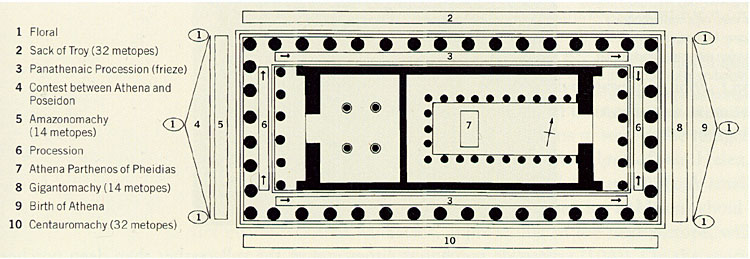
Plan of the Parthenon
showing positions and subjects of architectural sculpture
The Parthenon Pediments
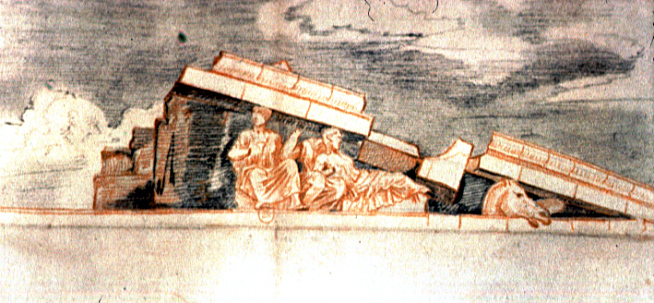
Jacques Carrey, drawing, 1674
East pediment, right side, Parthenon
(Bibliothèque Nationale, Paris)
The two pediments of the Parthenon, now in the British Museum, London, are almost 100 feet wide at the base and 11 feet high at the central peak.
Drawings made in 1674 by a Flemish artist (sometimes identified as Jacques Carrey) record the condition of the pediments of the Parthenon before the disastrous gun powder explosion of 1687. Carrey's rendering of the east pediment sculptures shows them still in a relatively good state of preservation, although the central figures had disappeared.
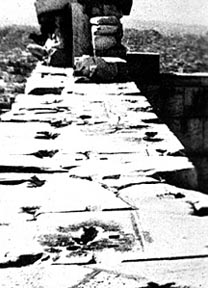

East Pediment, left side, Parthenon, Athens
The depth of the pediment bases is, however, only 36 inches, thus restricting the space available for the sculptures. Since the sides of the pediments slope toward the corner angles, Phidias had to solve the problem of fitting the sculptures into a diminishing triangular space.
The two goddesses on the left half of the east pediment, possibly Iris or Hebe, Demeter, and Persephone, reading from right to the left, are posed so that they fit logically into the triangular space. Their repeated diagonal planes relate to the two diagonals of the pediment, while the graceful curves of their garments harmonize with the architectural curves of the Doric order below.
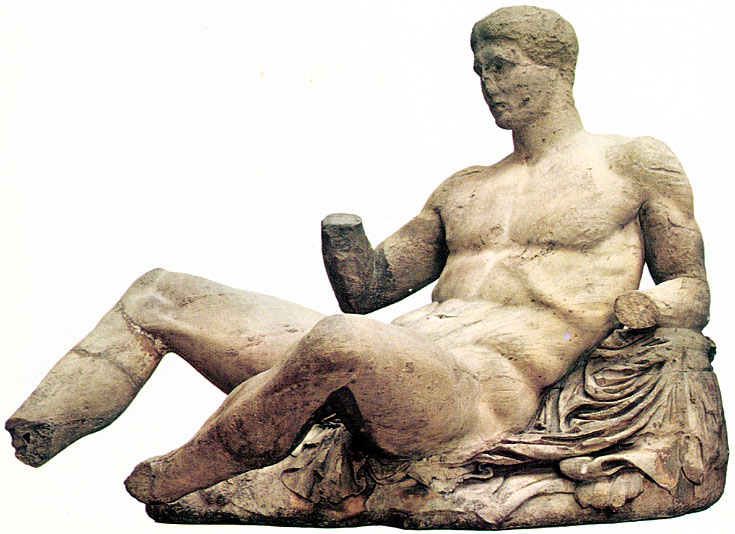
Reclining male figure (Dionysos?)
from the East Pediment, left side, of the Parthenon
c. 437-432 BCE
Marble, over-life-size
(British Museum, London)
 The reclining male nude to the left could be either Heracles or Dionysos. His limbs, like those of the goddesses, form a series of zigzag planes. His torso outlines a gentle curve, which is repeated in the domed head and organic muscle structure beneath the skin. Despite the naturalism of his pose and organic form, however, this figure is idealized; it has no facial expression or personality. The reclining male nude to the left could be either Heracles or Dionysos. His limbs, like those of the goddesses, form a series of zigzag planes. His torso outlines a gentle curve, which is repeated in the domed head and organic muscle structure beneath the skin. Despite the naturalism of his pose and organic form, however, this figure is idealized; it has no facial expression or personality.
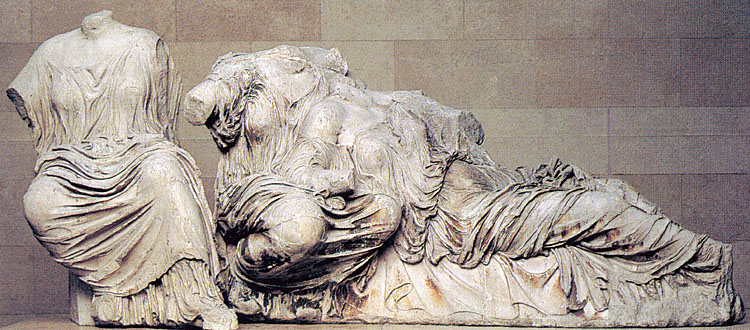
Three female figures (Goddesses? Fates?)
from the right side of the east pediment of the Parthenon
Marble, over-life-size
c. 437-432 BCE
(British Museum, London)
Mirroring the two seated females and the male on the left of the pediment is the group of three goddesses on the right. Their identity has been disputed by scholars because they have no attributes. Though posed slightly differently than their counterparts on the left, they match them closely. The reclining goddess relates to Dionysos/Heracles, and the two seated figures match Demeter and Persephone in the way they turn and wear curvilinear garments outlining their bodies.
The most dramatic correspondence between the two sides of the east pediment occurs at the angles. On the far left are the marble remnants of Helios's horses, pulling the chariot of the sun. They rise, beginning their daily journey across the sky. On the far right, a single horse's head descends, echoing the triangular shape of the pediment. This is a horse from the chariot of Selene, a moon goddess. Its form shows a remarkable understanding of anatomy, and the Classical genius for relating it to an aesthetic purpose. Phidias has created the illusion of a triangular cheek plate with one curved side, blood vessels, and muscles pushing against the inside of the skin. The right eye bulges from its socket, and the ear and clipped mane emerge convincingly from beneath the surface. The open mouth produces another triangular space, echoing the head, cheek plate, and the pediment itself.
The Parthenon Metopes
The Parthenon metopes are carved from Pentelic marble. Now housed in the British Museum, London, they illustrate four mythological battles. The best preserved were originally located on the south wall and represented the battle between Lapiths, a Greek tribe, and Centaurs, who were part human and part horse.

Lapith and Centaur
metope from the Parthenon, Athens
c. 447-438 BCE
Marble. Height 4' 5"
(British Museum, London)
According to this myth, the Lapiths invited the Centaurs to a wedding, but the Centaurs got drunk and tried to rape the Lapith boys and girls. The violent energy of the battle contrasts dramatically with the relaxing gods on the east pediment.
Each metope is approximately four feet square and contains high relief sculptures. There were fourteen metopes on the short east and west sides, and thirty-two on the long north and south sides. Most of them showed scenes of single combat.
The three other metope battles depicted Greeks against Amazons on the west, the Trojan War on the north, and Olympians overthrowing Giants on the east. Each set of metopes expressed one aspect of the Greek sense of superiority. The Lapiths and Centaurs symbolized the universal human conflict between animal instinct or lust - exemplified by the drunken Centaurs - and rational self-control -embodied by the Lapiths.
The Greek victory over the Amazons symbolized the triumph of Greek patriarchal culture over an earlier matriarchy. In the Trojan War, west triumphed over east, and in the clash between Giants and Olympians, the more human Greek gods wrested control of the universe from the primitive and cannibalistic pre-Greek Titans. According to the Parthenon metopes therefore, the civilization of Classical Greece was rational, patriarchal, and western, with an established human-based religion.
The Parthenon Frieze
Over the outside of the inner wall of the Parthenon, a 525 foot Ionic frieze illustrated the Greater Panathenaic procession.

Sectional drawing the Parthenon
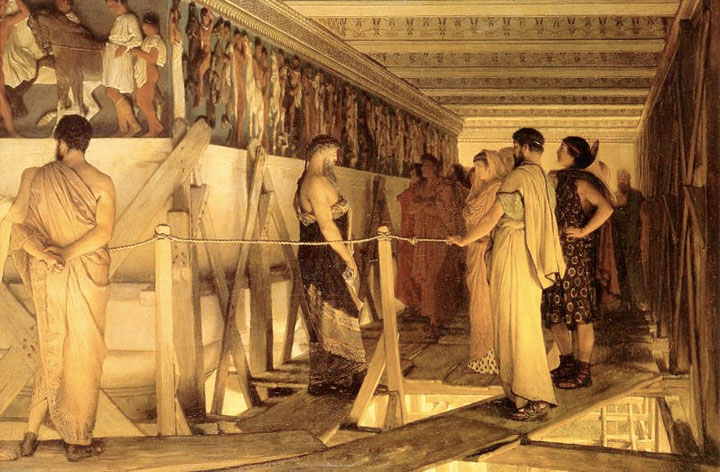
Phidias and the Frieze of the Parthenon (1868)
Lawrence Alma-Tadema (1836-1912)
(Birmingham Museums and Art Gallery)

Women and Elders
Detail of the east frieze from the Parthenon
c. 447-438 BCE
Marble. Height 3' 6"
(Louvre Museum, Paris)

Gods and Goddesses
Detail of the east frieze from the Parthenon
c. 447-438 BCE
Marble
(British Museum, London)

The peplos incident
Detail of the east frieze from the Parthenon
c. 447-438 BCE
Marble. Height 3' 6"
(British Museum, London)
The Greater Panathenaic procession was held every four years, and the entire city participated and presented a sacred robe to Athena. The continuous nature of the Ionic frieze, uninterrupted by triglyphs, is consistent with its content. Thus the shape of the frieze corresponds with the form of a procession. In order to maintain the horizontal plane of the figures, Phidias adopted the sculptural convention of isocephaly (from the Greek isos, meaning "equal" and kephalos, meaning "head"). When a work is isocephalic, the heads are set at approximately the same level.
TEMPLE OF ATHENA NIKE SCULPTURE
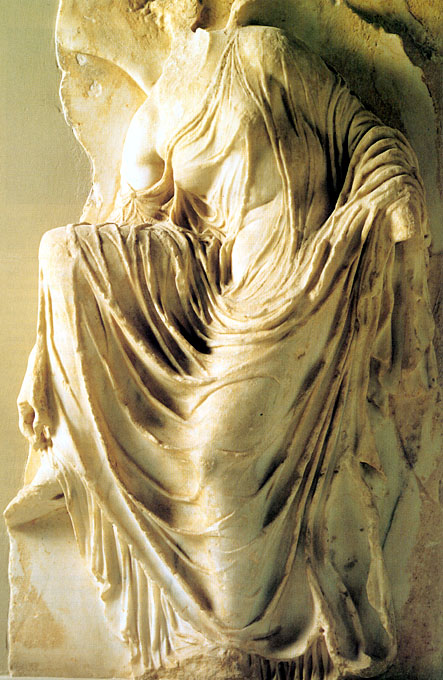
Nike (Victory) Adjusting Her Sandal
Relief from the balustrade of the Temple of Athena Nike
Marble. 3 feet 6 inches high
c. 410-404 BCE
(Acropolis Museum, Athens)
The best example of relief sculpture from the Temple of Athena Nike is Nike Adjusting Her Sandal, originally located on a balustrade of the parapet. This figure combines a graceful curved torso with diagonal planes in her legs. The sheer, almost transparent drapery called "wet drapery" because it appears to cling to the body - falls in a pattern of elegant repeated folds. Behind the Nike is the remnant of an open wing. Its smooth surface contrasts with the activated drapery, and at the same time echoes and frames the torso's curve.
The figure was part of a relief depicting Victories (Nikai) erecting trophies or bringing sacrificial animals to Athena. Emphasis is on beautiful decoration - a departure from the style of the Parthenon scultures in the new interest in transparent drapery, elegance, and mannered gracefulness.
|

 SPRING 2016
SPRING 2016  SCHEDULE
SCHEDULE  REQUIREMENTS
REQUIREMENTS

 SPRING 2016
SPRING 2016  SCHEDULE
SCHEDULE  REQUIREMENTS
REQUIREMENTS